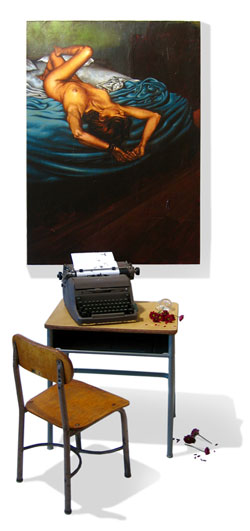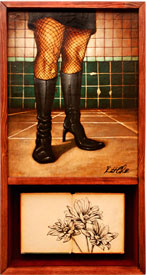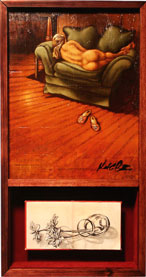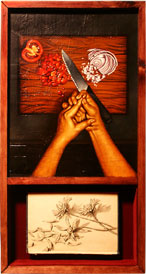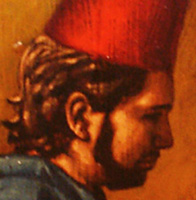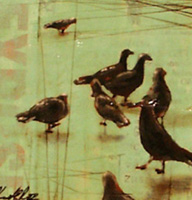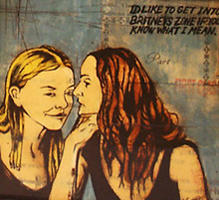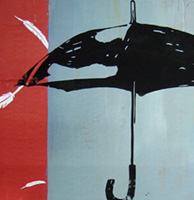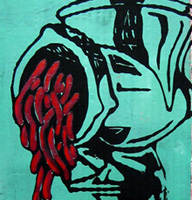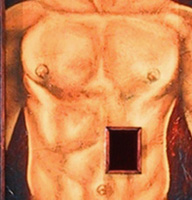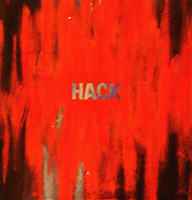|
|
 |
 |
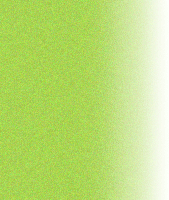 |
||
 |
||
 |
||
 |
||
 |
||
 |
||
 |
||
 |
||
 |
||
 |
||
 |
||
 |
||
 |
||
 |
||
 |
||
 |
||
 |
||
 |
||
 |
||
 |
||
 |
||
 |
||
 |
||
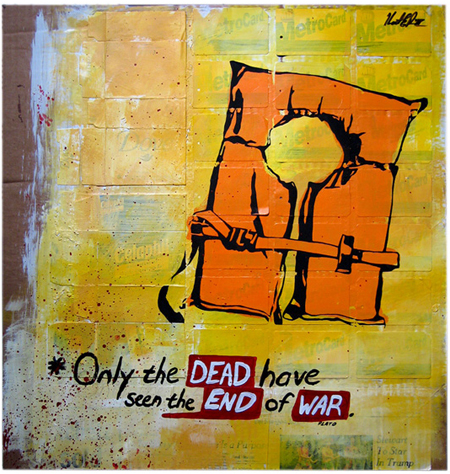
Of Trash and Tyranny:The Art of Kenneth E. Parris III
By Dee Dee Vega
The Article Series utilizes the familiar verbal/visual language of his early constructions, but is anchored in a specific event in Parris’s life at a particular moment in time. These works seek to explore his relationship and understanding of a specific happening or event as it evolves with the artistic process. Articles 2.1, Article 2.2, Article 2.3 are very personal yet illusive images with no discernable connection to the secret event in Parris’s life. The boxes consist of a painting and in this case, a blank book—mounted and drawn upon. There is something about the paintings that seem to intentionally nod (or perhaps wink is a better word) to pop culture imagery. The linear hard edge and sexually rife renderings are the unsuspecting lovechild of R. Crumb and Caravaggio. 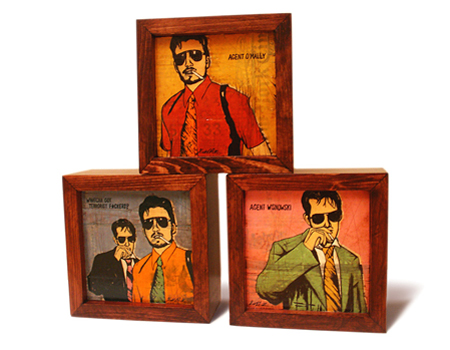
Parris’s art has taken new form and ventured into far more topical and politically charged subject matter. His Concept Blocks are 5.5 inch paintings placed in a solid wood form constructed by the artist. They are not meant to hang, but rather their weighty presence felt on a physical surface or in your hand—a tactile toy, conceptual building blocks if you will. The Homeland Security Series for example, are paintings of mysterious sunglass-masked figures a la Matrix (which strangely resemble Matt Dillon, as I look at them) that are layered on top of advertisements and other mass-produced paper. The images are familiar and disturbing painted in broad and vivid colors. 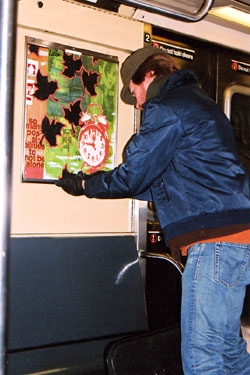 Parris’s most recent body of work, his Direct Action Art, has taken on an entirely new form and thus a whole new frame
of involvement commenting on the tyrannical and empirical capitalist American political situation. The Direct Action
pieces are constructed from cardboard and often utilize mass produced objects and images from the media coupled with silk screened
pictures and text. The pieces themselves are “removable” graffiti. They are designed to fit into the space that holds
advertisements in New York City subway cars where riders are bombarded every day with the unrelenting pressure to consume.
The subway patrons are the ultimate judges of the work as they can remove it, keep it, destroy it or leave it there to see.
Parris has created certain silk-screen images—a meat grinder, an umbrella, a bird—that are repeated and paired with different
backgrounds and political statements. Of course, artists such as Jenny Holtzer and Barbara Kruger have created highly visible
artworks that employ the same tactics. But Parris’s distinction relies upon the fact that the works of art are not only
anti-capitalist in both their explicit ideology and “free” public exhibition—but are highly ephemeral in their use of common,
discarded materials. I think Dewey would have approved.
Parris’s most recent body of work, his Direct Action Art, has taken on an entirely new form and thus a whole new frame
of involvement commenting on the tyrannical and empirical capitalist American political situation. The Direct Action
pieces are constructed from cardboard and often utilize mass produced objects and images from the media coupled with silk screened
pictures and text. The pieces themselves are “removable” graffiti. They are designed to fit into the space that holds
advertisements in New York City subway cars where riders are bombarded every day with the unrelenting pressure to consume.
The subway patrons are the ultimate judges of the work as they can remove it, keep it, destroy it or leave it there to see.
Parris has created certain silk-screen images—a meat grinder, an umbrella, a bird—that are repeated and paired with different
backgrounds and political statements. Of course, artists such as Jenny Holtzer and Barbara Kruger have created highly visible
artworks that employ the same tactics. But Parris’s distinction relies upon the fact that the works of art are not only
anti-capitalist in both their explicit ideology and “free” public exhibition—but are highly ephemeral in their use of common,
discarded materials. I think Dewey would have approved.
Ken Parris’s future projects include further installations and the continuation of his Direct Action series, as well as acting as Art Director for the film Permanent Tear for the production company Paramichari. Mr. Parris is also designing the cover of the upcoming Willpilot album “Okay Good.” Mr. Parris’s work can be purchased directly through the artist at kenparris3@yahoo.com.
Previous Art Stars...Sean Fader Photography
|
|
|
|
||||||||||
|
|
|||||||||||
|
|
|
|
|||||||||
|
|
|||||||||||
|
|
|||||||||||
|
|
|||||||||||
|
|
|
|
|||||||||
|
|
|||||||||||
|
|
|||||||||||
|
|
|||||||||||
|
|
|
|
|||||||||
|
|
|||||||||||
|
|
|||||||||||
|
|
|||||||||||
|
|
|
|
|||||||||
|
|
|||||||||||
|
|
|||||||||||
|
|
|||||||||||
|
|
|
|
|||||||||
|
|
|||||||||||
|
|
|||||||||||
|
|
|||||||||||
|
|
|
|
|||||||||
|
|
|||||||||||
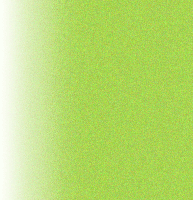 |
|||||||||||
 |
|||||||||||
 |
|||||||||||
 |
|||||||||||
 |
|||||||||||
 |
|||||||||||
 |
|||||||||||
 |
|||||||||||
 |
|||||||||||
 |
|||||||||||
 |
|||||||||||
 |
|||||||||||
 |
|||||||||||
 |
|||||||||||
 |
|||||||||||
 |
|||||||||||
 |
|||||||||||
 |
|||||||||||
 |
|||||||||||
 |
|||||||||||
 |
|||||||||||
 |
|||||||||||
 |
|||||||||||
|
|
|
|
|
|
|
|
|
|
|
|
|
